Limiting reactants - Study guides, Class notes & Summaries
Looking for the best study guides, study notes and summaries about Limiting reactants? On this page you'll find 245 study documents about Limiting reactants.
Page 2 out of 245 results
Sort by
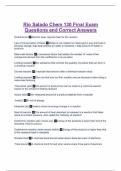
-
Rio Salado Chem 130 Final Exam Questions and Correct Answers
- Exam (elaborations) • 12 pages • 2024
-
- $9.99
- + learn more
Endothermic Absorbs heat, requires hear for the reaction Law of Conservation of Mass Matter is not created nor destroyed in any chemical or physical change, ergo total amount of matter in reactants = total amount of matter in products Mole-mole factors a conversion factor that relates the number of moles of two compounds derived from the coefficients in an equation Limiting reactant the substance that controls the quantity of product that can form in a chemical reaction Excess reactant a rea...
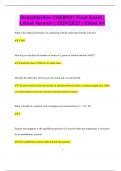
-
Straighterline CHEM101 Final Exam | Latest Version | 2024/2025 | Rated A+
- Exam (elaborations) • 52 pages • 2024
-
- $11.68
- + learn more
Straighterline CHEM101 Final Exam | Latest Version | 2024/2025 | Rated A+ What is the empirical formula of a compound with the molecular formula C6H12O6? CH2O How do you calculate the number of moles in 5 grams of sodium chloride (NaCl)? Divide the mass of NaCl by its molar mass. Describe the difference between an ionic bond and a covalent bond. An ionic bond involves the transfer of electrons between atoms, creating charged ions, while a covalent bond involves the sharing of ...
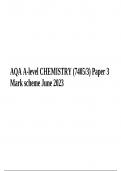
-
AQA A-level CHEMISTRY (7405/3) Paper 3 Mark scheme June 2023
- Exam (elaborations) • 30 pages • 2024
-
- $13.49
- + learn more
AQA A-level CHEMISTRY (7405/3) Paper 3 Mark scheme June 2023. catalyst ALLOW reduces Ea IGNORE speeds up reaction IGNORE provides alternative path IGNORE proton donor IGNORE dehydrating agent 1 Question Answers Additional comments/Guidelines Mark 1.2 electric heater/heat mantle or (hot) water bath IGNORE not with a Bunsen/naked flame / gently ALLOW hot water ALLOW heating/hot plate/ sand bath / oil bath ALLOW reference to flame/Bunsen if in context of heating a water bath NOT any ind...
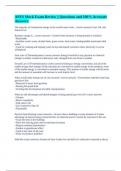
-
APES Mock Exam Review || Questions and 100% Accurate Answers.
- Exam (elaborations) • 14 pages • 2024
-
Available in package deal
-
- $11.59
- + learn more
The majority of commercial energy in the world comes from... correct answers Coal, Oil, and Natural Gas Biomass energy is... correct answers ~Created when biomass is being burned or oxidized ~Renewable ~Includes wood, waste, alcohol fuels, green waste, food waste, biodegradable municipal solid waste ~Used for cooking and keeping warm in less-developed countries where electricity is not as widespread First Law of Thermodynamics correct answers Energy involved in any physical or chemical ...
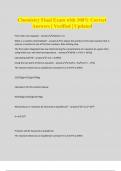
-
Chemistry Final Exam with 100% Correct Answers | Verified | Updated
- Exam (elaborations) • 17 pages • 2024
- Available in package deal
-
- $12.49
- + learn more
Chemistry Final Exam with 100% Correct Answers | Verified | Updated First order rate equation - answerln(Ao/A) = kt What is a reaction intermediate? - answerIt's always the product in the slow reaction that is used as a reactant in one of the fast reactions. Rate limiting step. The first order integrated rate law: Determining the concentration of a reactant at a given time using initial conc and rate by temperature. - answerln[A]t = e^(-kt + ln[A]₀) Calculating half-life - answert 1/2 ...
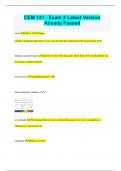
-
CEM 141 - Exam 2 Latest Version Already Passed
- Exam (elaborations) • 14 pages • 2024
- Available in package deal
-
- $9.99
- + learn more
CEM 141 - Exam 2 Latest Version Already Passed mole 6.022 x 10^23 things number of particles that allows us to convert from the molecular to the macroscopic level limiting reactant/reagent amount of one of the reactants which limits how much product can be formed. smallest amount. percent yield actual/theoretical x 100 electromagnetic radiation wavelength The distance between two corresponding parts of a wave. seconds/wave. 1/frequency. measured in m amplitude Height of ...
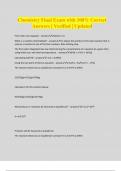
-
Chemistry Final Exam with 100% Correct Answers | Verified | Updated
- Exam (elaborations) • 17 pages • 2024
- Available in package deal
-
- $12.49
- + learn more
Chemistry Final Exam with 100% Correct Answers | Verified | Updated First order rate equation - answerln(Ao/A) = kt What is a reaction intermediate? - answerIt's always the product in the slow reaction that is used as a reactant in one of the fast reactions. Rate limiting step. The first order integrated rate law: Determining the concentration of a reactant at a given time using initial conc and rate by temperature. - answerln[A]t = e^(-kt + ln[A]₀) Calculating half-life - answert 1/2 ...
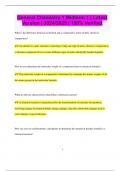
-
General Chemistry 1 Midterm 1 | Latest Version | 2024/2025 | 100% Verified
- Exam (elaborations) • 17 pages • 2024
- Available in package deal
-
- $9.73
- + learn more
General Chemistry 1 Midterm 1 | Latest Version | 2024/2025 | 100% Verified What is the difference between an element and a compound in terms of their chemical composition? An element is a pure substance consisting of only one type of atom, whereas a compound is a substance composed of two or more different types of atoms chemically bonded together. How do you determine the molecular weight of a compound from its chemical formula? The molecular weight of a compound is determined by s...
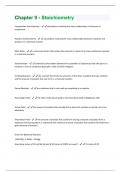
-
Chapter 9 - Stoichiometry Questions And Answers With Latest Updates
- Exam (elaborations) • 2 pages • 2024
- Available in package deal
-
- $7.99
- + learn more
Composition Stoichiometry - calculations involving the mass relationships of elements in compounds Reaction Stoichiometry - calculations involving the mass relationships between reactants and products in a chemical reaction Mole Ratio - a conversion factor that relates the amounts in moles of any two substances involved in a chemical reaction Stoichiometry - (chemistry) the relation between the quantities of substances that take part in a reaction or form a compound (typically a ratio of ...
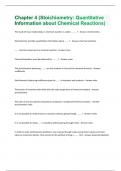
-
Chapter 4 (Stoichiometry: Quantitative Information about Chemical Reactions) Questions And Answers With Latest Updates
- Exam (elaborations) • 4 pages • 2024
- Available in package deal
-
- $7.99
- + learn more
The study of mass relationships in chemical reactions is called ₋₋₋₋₋₋₋ ? - Answer-stoichiometry Stoichiometry provides quantitative information about ₋₋₋₋₋ ? - Answer-chemical reactions ₋₋₋₋₋ must be conserved in a chemical reaction - Answer-mass Chemical Equations must be balanced for ₋₋₋₋₋₋ ? - Answer-mass The stoichiometric balancing ₋₋₋₋₋₋ are the numbers in front of the chemical formulas - Answercoefficients Stoichiometric bala...

How much did you already spend on Stuvia? Imagine there are plenty more of you out there paying for study notes, but this time YOU are the seller. Ka-ching! Discover all about earning on Stuvia


